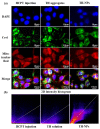Mitochondrial-Targeted Triphenylphosphonium-Hydroxycamptothecin Conjugate and Its Nano-Formulations for Breast Cancer Therapy: In Vitro and In Vivo Investigation
- PMID: 36839710
- PMCID: PMC9961676
- DOI: 10.3390/pharmaceutics15020388
Mitochondrial-Targeted Triphenylphosphonium-Hydroxycamptothecin Conjugate and Its Nano-Formulations for Breast Cancer Therapy: In Vitro and In Vivo Investigation
Abstract
Mitochondria are involved in various stages of cancer cell diffusion and metastasis. Therefore, targeting tumor mitochondria with antineoplastic medicines to cause mitochondria to initiate apoptosis may be an effective strategy for cancer therapy. Here, in order to enhance the anti-tumor efficacy of the antineoplastic agent hydroxycamptothecin (HCPT), the mitochondrial targeting ligand 4-(carboxybutyl) triphenylphosphine bromide (TPP) was attached to HCPT by an ester linkage. The resultant TPP-HCPT (TH) conjugate could self-assemble into nano-aggregates, with a mean particle size of 203.2 nm and a polydispersity index (PDI) value of 0.312. The TH conjugate could also co-assembly with mPEG3000-PLGA5000 into nanoparticles (TH-NPs), with a mean diameter of 86.41 nm, a PDI value of 0.256 and a zeta potential of -0.125 mV. In contrast to HCPT injections, TH aggregates displayed enhanced cellular uptake, mitochondria-targetability and cytotoxicity against 4T1 cells, while TH-NPs showed even better improvement than TH aggregates. In the in vivo study, TH aggregates displayed higher anti-tumor efficacy in 4T1 tumor-bearing mice than HCPT injections (tumor inhibition rate, 55.71% vs. 69.17%), and TH-NPs displayed more superior anti-tumor effects (tumor inhibition rate, 80.02%). In conclusion, our research demonstrated that the TPP-HCPT conjugate and its nano-formulations, including TH aggregates and TH-NPs, may be a promising mitochondria-targeting anticancer medicine for cancer therapy. As far as we know, this is the first report in which TPP and HCPT have been conjugated directly for this aim.
Keywords: hydroxycamptothecin; mitochondrial targeting; nanoparticles; triphenylphosphine.
Conflict of interest statement
The authors declare no conflict of interest.
Figures











Similar articles
-
Preparation of 10-hydroxycamptothecin-loaded glycyrrhizic acid-conjugated bovine serum albumin nanoparticles for hepatocellular carcinoma-targeted drug delivery.Int J Nanomedicine. 2013;8:1207-22. doi: 10.2147/IJN.S40493. Epub 2013 Mar 27. Int J Nanomedicine. 2013. PMID: 23569373 Free PMC article.
-
10-Hydroxycamptothecin (HCPT) nanosuspensions stabilized by mPEG1000-HCPT conjugate: high stabilizing efficiency and improved antitumor efficacy.Int J Nanomedicine. 2017 May 12;12:3681-3695. doi: 10.2147/IJN.S134005. eCollection 2017. Int J Nanomedicine. 2017. PMID: 28553107 Free PMC article.
-
Cell-penetrating Peptide-modified Targeted Drug-loaded Phase-transformation Lipid Nanoparticles Combined with Low-intensity Focused Ultrasound for Precision Theranostics against Hepatocellular Carcinoma.Theranostics. 2018 Feb 14;8(7):1892-1910. doi: 10.7150/thno.22386. eCollection 2018. Theranostics. 2018. PMID: 29556363 Free PMC article.
-
Glycyrrhetinic Acid and TAT Peptide Modified Dual-functional Liposomes for Treatment of Hepatocellular Cancer.Curr Top Med Chem. 2020;20(27):2493-2505. doi: 10.2174/1568026620666200722110244. Curr Top Med Chem. 2020. PMID: 32703132
-
Mitochondrial-Targeting Anticancer Agent Conjugates and Nanocarrier Systems for Cancer Treatment.Front Pharmacol. 2018 Aug 17;9:922. doi: 10.3389/fphar.2018.00922. eCollection 2018. Front Pharmacol. 2018. PMID: 30174604 Free PMC article. Review.
References
-
- Kalyanaraman B., Cheng G., Hardy M., Ouari O., Lopez M., Joseph J., Zielonka J., Dwinell M.B. A review of the basics of mitochondrial bioenergetics, metabolism, and related signaling pathways in cancer cells: Therapeutic targeting of tumor mitochondria with lipophilic cationic compounds. Redox. Biol. 2018;14:316–327. doi: 10.1016/j.redox.2017.09.020. - DOI - PMC - PubMed
Grants and funding
LinkOut - more resources
Full Text Sources
Research Materials

